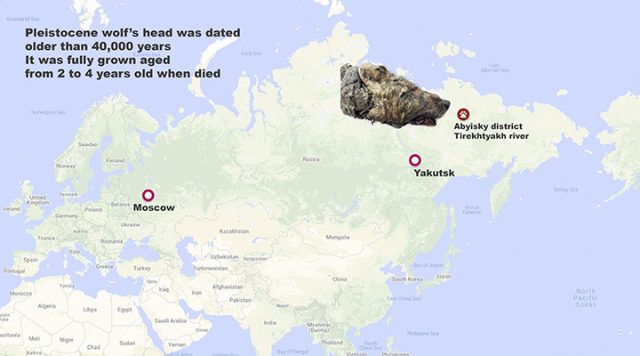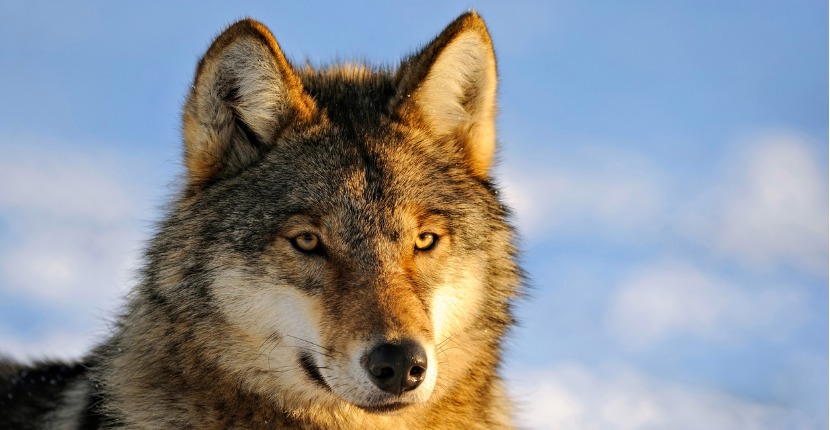An amazingly well-preserved head of an ancient wolf has been identified. A Russian man named Pavel Efimov was out for a walk last summer when he came across a startling sight. Along the shore of the Tirekhtyakh River in Siberia’s Yakutia, he spotted a huge severed animal head. On closer inspection, it looked like it could be a wolf–with a full head of hair. Its long sharp teeth were intact, making the beast look as if it were still snarling.
The scientists that Efimov carried the head to ran many tests and have just concluded that it was indeed a wolf and estimated the animal was about 40,000 years old. The head alone measured a whopping 16 inches in length. And, yes, the brain was intact.
“This is a unique discovery of the first-ever remains of a fully grown Pleistocene wolf with its tissue preserved,” paleontologist Albert Protopopov from the Republic of Sakha Academy of Sciences told The Siberian Times. “We will be comparing it to modern-day wolves to understand how the species has evolved and to reconstruct its appearance.”
Still snarling after 40,000 years, a giant Pleistocene wolf discovered in Yakutia.
Sensational find of head of the beast with its brain intact, preserved since prehistoric times in permafrost.https://t.co/w4FoRB16Ur pic.twitter.com/8QbthEfay1— The Siberian Times (@siberian_times) June 8, 2019
It is believed that the wolf head was for thousands of years preserved in permafrost in the Yakutia region, which has the lowest temperatures in the Northern Hemisphere. The predator has a thick “mammoth-like” coat and fangs larger than that of any wolves in Siberia today.
No one has any idea why the wolf’s head was severed. “But scientists say it is unlikely to have been the trophy of a hunter because early man only started to arrive in this part of northern Russia around 32,500 years ago,” according to the Mirror. The scientific analysis concluded that the wolf was fully grown and between 2 and 4 years old when it died.
A 40,000-year-old severed wolf’s head, preserved by permafrost complete with teeth and fur, has been discovered in eastern Siberia https://t.co/fg6r8gPNDf
— CNN (@CNN) June 12, 2019
Scientists at the Swedish Museum of Natural History will examine the DNA from the wolf head and compare its genetics to modern wolves, The Siberian Times reported. This work will include using tomographic techniques to non-invasively see inside the skull.

The wolf head went on display in Tokyo as part of an exhibition on woolly mammoths and other frozen creatures. “Alongside the wolf, the scientists presented an immaculately-well preserved cave lion cub,” said The Siberian Times. “Their muscles, organs, and brains are in good condition,’ said Naoki Suzuki, a professor of paleontology and medicine with the Jikei University School of Medicine in Tokyo, who studied the remains with a CT scanner. “We want to assess their physical capabilities and ecology by comparing them with the lions and wolves of today.”
According to Protopopov, finding wolf skulls in thawing Siberian permafrost isn’t uncommon, but they’re rarely on the same level as this massive predator. “Several puppies have already been found,” Protopopov told the Interfax News Agency. “The uniqueness of this find is that we found the head of an adult wolf with perfectly preserved soft tissues and brain.”
Giant wolfs are known to have walked the earth during the Pleistocene era, which spanned a time period between 1.8 million and 10,000 years ago and also marked an era of global cooling. Much of our world’s land masses were covered by glaciers and permafrost layers.
Related Article: Amazingly Well-Preserved Ice Age Horse Discovered in Siberian Permafrost
An assortment of very large mammals existed then. Not since the age of dinosaurs 65 million years before had so many animals of such great size and strength roamed. Besides wolfs, there were bison, wild horses, giant ground sloths, mammoths, giant short-faced bears, saber-tooth cats, and woolly rhinoceros.
Nancy Bilyeau, a former staff editor at Entertainment Weekly, Rolling Stone, and InStyle, has written a trilogy of historical thrillers for Touchstone Books. Her new book, The Blue, is a spy story set in the 18th-century porcelain world. For more information, go to www.nancybilyeau.com
